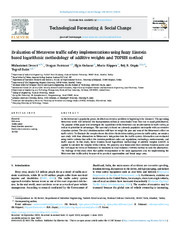Please use this identifier to cite or link to this item:
https://rfos.fon.bg.ac.rs/handle/123456789/2548Full metadata record
| DC Field | Value | Language |
|---|---|---|
| dc.creator | Deveci, Muhammet | |
| dc.creator | Pamučar, Dragan | |
| dc.creator | Gokasar, Ilgin | |
| dc.creator | Köppen, Mario | |
| dc.creator | Gupta, Brij B. | |
| dc.creator | Daim, Tugrul | |
| dc.date.accessioned | 2023-06-29T07:21:50Z | - |
| dc.date.available | 2023-06-29T07:21:50Z | - |
| dc.date.issued | 2023 | |
| dc.identifier.issn | 0040-1625 | |
| dc.identifier.uri | https://rfos.fon.bg.ac.rs/handle/123456789/2548 | - |
| dc.description.abstract | As the Metaverse's popularity grows, its effect on everyday problems is beginning to be discussed. The upcoming Metaverse world will influence the transportation system as cross-border lines blur due to rapid globalization. The purpose of this paper is to investigate the capabilities of the Metaverse and its alternatives to traffic safety, as well as to prioritize its advantages. The case study is based on a densely populated metropolis with an extensive education system. The city's decision-makers will have to weigh the pros and cons of the Metaverse's effect on traffic safety. To illustrate the complex forces that drive the decision-making process in traffic safety, we create a case study with four alternatives to Metaverse's integration into the traffic system. Alternatives are evaluated using twelve criteria that reflect the decision problem's rules and regulations, technology, socioeconomic, and traffic aspects. In this study, fuzzy Einstein based logarithmic methodology of additive weights (LMAW) is applied to calculate the weights of the criteria. We present a new framework that combines Einstein norms and the Technique for Order of Preference by Similarity to Ideal Solution (TOPSIS) method to rank the alternatives. The findings of this study show that public transportation is the most appropriate area for implementing the Metaverse into traffic safety because of its practical opportunities and broad usage area. | |
| dc.language | en | |
| dc.publisher | Elsevier | |
| dc.rights | openAccess | |
| dc.rights.uri | https://creativecommons.org/licenses/by/4.0/ | |
| dc.source | Technological Forecasting and Social Change | |
| dc.subject | Fuzzy Einstein operators | |
| dc.subject | Metaverse | |
| dc.subject | Multi-criteria decision making | |
| dc.subject | TOPSIS | |
| dc.subject | Traffic safety | |
| dc.title | Evaluation of Metaverse traffic safety implementations using fuzzy Einstein based logarithmic methodology of additive weights and TOPSIS method | |
| dc.type | article | en |
| dc.rights.license | BY | |
| dc.citation.rank | M21a~ | |
| dc.citation.spage | 122681 | |
| dc.citation.volume | 194 | |
| dc.identifier.doi | 10.1016/j.techfore.2023.122681 | |
| dc.identifier.fulltext | http://prototype2.rcub.bg.ac.rs/bitstream/id/3762/Evaluation.pdf | |
| dc.identifier.scopus | 2-s2.0-85161717939 | |
| dc.type.version | publishedVersion | |
| item.cerifentitytype | Publications | - |
| item.fulltext | With Fulltext | - |
| item.grantfulltext | open | - |
| item.openairetype | article | - |
| item.openairecristype | http://purl.org/coar/resource_type/c_18cf | - |
| Appears in Collections: | Radovi istraživača / Researchers’ publications | |
Files in This Item:
| File | Description | Size | Format | |
|---|---|---|---|---|
| Evaluation.pdf | 2.47 MB | Adobe PDF |  View/Open |
This item is licensed under a Creative Commons License

